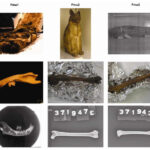Cats are beloved pets, but sometimes a scratch can lead to more than just a minor skin irritation. Cat scratch disease (CSD), also known as cat scratch fever, is a bacterial infection caused by Bartonella henselae. While often mild, understanding how cats get infected and how to prevent transmission is crucial for cat owners and anyone who interacts with these animals.
How Cats Get Infected with Bartonella henselae
The primary culprit behind Cat Scratch Bacteria Infection is Bartonella henselae. Cats commonly contract this bacteria through flea bites. When fleas carrying Bartonella feed on a cat, they can transmit the bacteria into the cat’s bloodstream. Another less frequent mode of transmission among cats is through fights, where infected cats can pass the bacteria to others via scratches and bites. In rare cases, feline blood transfusions can also spread Bartonella.
Interestingly, many cats carrying Bartonella remain asymptomatic, meaning they show no signs of illness. These cats are carriers, harboring the bacteria in their blood without experiencing adverse health effects. Studies indicate that a significant portion of healthy cats, particularly kittens, can carry Bartonella, with some research finding the bacteria in up to one-third of healthy feline populations.
When to Worry: Symptoms in Cats
While most cats infected with Bartonella don’t get sick, some may develop symptoms. If a cat does become ill from a Bartonella infection, the illness is typically mild and short-lived. The most common symptom in cats is a transient fever that lasts for 2 to 3 days.
Testing and Treatment for Cats
For healthy cats showing no signs of illness, routine Bartonella testing and treatment are generally not recommended. Antibiotic treatment for Bartonella in cats can be lengthy and is usually reserved for symptomatic animals.
Veterinary care is advised if your cat exhibits symptoms that are more severe or prolonged. Signs that warrant a vet visit include:
- Fever lasting longer than 3 days
- Vomiting
- Lethargy or unusual tiredness
- Redness of the eyes (conjunctivitis)
- Swollen lymph nodes
- Decreased appetite
If your cat displays these symptoms, consult with your veterinarian to determine the best course of action.
Cat Scratches and Human Risk
Cat scratches are a common occurrence, especially for cat owners. Fortunately, the vast majority of cat scratches do not lead to cat scratch disease. However, it’s important to take proper care of any scratch wound.
Recognizing Cat Scratch Disease in Humans
If you are scratched by a cat, immediately wash the wound thoroughly with soap and water. Monitor for potential signs of cat scratch disease. Symptoms in humans typically develop 1 to 3 weeks after a scratch from an infected cat.
Key symptoms of cat scratch disease in humans include:
- Fever
- Enlarged and tender lymph nodes near the scratch site
- A pustule or small bump at the scratch location
Treatment for Humans
In many cases, cat scratch disease in humans is a self-limiting illness, meaning it resolves on its own without specific treatment. Antibiotics are often not necessary for CSD in humans. However, in some instances, antibiotics may be prescribed, particularly to help reduce lymph node swelling and discomfort. If you suspect you have cat scratch disease, it’s best to consult with your healthcare provider for proper diagnosis and guidance.
Cat Ownership and Weakened Immune Systems
Individuals with weakened immune systems, such as those living with HIV or undergoing cancer treatment, often have concerns about pet ownership and potential infections. Having a cat does not necessarily need to be avoided for immunocompromised individuals.
Reducing Your Risk of CSD
The risk of contracting cat scratch disease can be minimized by following preventive measures:
- Keep your cat indoors: Indoor cats have less exposure to fleas and other infected animals.
- Avoid scratches, bites, and licks: Be mindful when playing with your cat and avoid situations where scratches or bites are likely. Declawing is not recommended as a preventative measure for CSD.
- Promptly wash wounds: Immediately clean any cat scratches or bites with soap and water.
- Control fleas: Implement effective flea control measures for your cat, as recommended by your veterinarian.
- Consider the cat’s age and health: When getting a new cat, opt for cats that are at least one year old, in good health, and flea-free.
- Avoid stray cats: Stray cats and cats with flea infestations pose a higher risk of carrying Bartonella.
By taking these precautions, even individuals with weakened immune systems can often safely enjoy the companionship of a feline friend.
Preventing Cat Scratch Disease: Practical Tips
Preventing cat scratch bacteria infection involves a combination of responsible pet ownership and personal hygiene practices. Here are key steps to minimize the risk of CSD:
- Flea Control is Key: Regular flea prevention for your cat is the most effective way to reduce the risk of Bartonella infection in both cats and humans. Consult your veterinarian for the best flea control product for your cat.
- Handle Cats Carefully: Teach children and adults to handle cats gently and avoid rough play that could lead to scratches and bites.
- Wash Hands After Contact: Wash your hands thoroughly with soap and water after playing with or handling cats, especially before eating or touching your face.
- Don’t Allow Cats to Lick Open Wounds: Prevent cats from licking any open wounds you may have, as this can also transmit bacteria.
- Consider Older Cats: If you are particularly concerned about CSD risk, adopting an adult cat over a kitten may be slightly lower risk, as kittens are more likely to carry Bartonella.
By implementing these simple yet effective strategies, you can significantly reduce the risk of cat scratch bacteria infection and enjoy a healthy and happy relationship with your feline companion.


